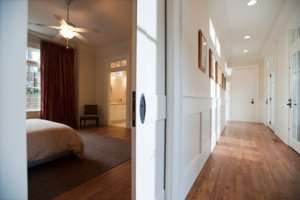
Making homes suitable for elderly occupants is easy to describe, but it can be very expensive to do. The cheapest solution is to make homes senior-friendly when they are built, rather than trying to retrofit them. Some of the most elegant and cost-effective solutions are recognized each year by AARP and the National Association of Home Builders. The winning designs employ imaginative solutions that reduce energy consumption and use smart communications tools for home security and health-related "telemedical" applications. It will be some time before these "early adapter" designs are widely available. But they point the way toward solutions that older residents should explore for their existing homes or in new housing if they are considering such a move.
[Slide Show: Design Awards Enable Aging in Place.]
Universal design is the broader and official term that encompasses senior-friendly housing. Stripped of high-tech and innovative green solutions, universal design boils down to making housing spaces and commonly used features more accessible to the broadest range of occupants. If you have trouble grasping what this means, imagine trying to navigate your home in a wheelchair. Could you even get into your home without someone else's help? Could you use the bathroom? Navigate hallways and living areas? Fix a meal in your kitchen?
[See America's Most Affordable Places to Retire .]
Here are some of the features in the recently announced AARP-NAHB awards that enable these activities and much more.
Eskaton Senior Residences in Roseville, Calif., won a builder's award for homes of less than 2,500 square feet. The house was developed as a demonstration home for Eskaton, which offers a range of senior support services to more than 14,000 people in northern California. It includes easy-access features and, like other winners, enables future accessibility modifications by, for example, including extra wiring in the walls and reinforcing key areas of the home for future installation of railings and grab bars. Since it's a demonstration model, this home is packed with more bells and whistles than you might ever need, or could afford, including:
[See Functional Design Solutions for Aging Homeowners .]
Yorkshire Enterprises in Atlanta won an award for residences exceeding 2,500 square feet. Its four-story home has a ground-floor master suite with a bathroom that has a waterproof floor, roll-in shower, and wheelchair-accessible sink. The home's levels can be accessed by an elevator. Like other winning designs, the home minimizes entry elevations and has very wide hallways and doorways. The kitchen features easily accessible appliances, including a microwave in a drawer.
ZAI in Seattle won an award for architectural home design. While single-floor home layouts provide easy access solutions for older residents, they tend to beexpansive and therefore may not be feasible in more densely populated areas and older neighborhoods. ZAI's multistory design includes a separate ground-floor living unit with its own kitchen and bathroom for use by a senior or a caregiver. It includes an elevator shaft that is currently filled with closets and nooks on three living levels but which could be cost-effectively converted into an elevator if the need arises. Stairways are broken into smaller runs of a few stairs to minimize the impact of falls. Level doorway thresholds and curbless showers are included, and doorknobs are replaced with lever handles. A base cabinet under the bathroom sink is on lockable rollers and can be removed if the occupants need wheelchair access to the sink.
The Lakota Group in Chicago won the fourth award for developing the NorthCenter Senior Campus. The three residential buildings include many attractive common-area social, health, and recreational features for occupants of the 282 living units. But perhaps the greatest accomplishment of the affordable housing complex is that it was built at all. Pulling together the 8-acre former hospital site on Chicago's congested North Side required an extensive partnership of government and private interests. One of the existing medical buildings was saved and can provide accessible healthcare services to residents and other citizens.
Compare Offers
Compare Offers



Post a Comment